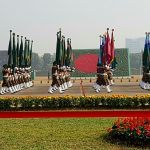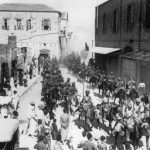VALOUR IS BUT DUTY
Traditionally battles hailed the most by armies are often the ones they win at great loss of lives, evidently for sentimental reasons. Consequently many a battle won with minimum casualties due to professional excellence of planning and execution earns far less renown. Nothing demonstrates this in the history of warfare than the fixation of the British with the ‘Charge of the Light Brigade’, wherein 6oo of their cavalrymen rode to their death against Russian cannons in Crimea in a classic instance of foolhardiness, while many a brilliant feat of British arms are largely forgotten.
In India’s own recent military history, our spectacular victory in 1971 War is a case in point. While the liberation of Bangladesh in that war is much hailed as India’s grand military achievement and a certain amount of credit given to Indian Army’s Eastern Command for the successful strategy employed, no proper recognition has ever been accorded to the contribution of individual soldiers and units that took part in Operation Cactus Lily and their professionalism that made the victory possible. May be the toll of casualties, 1500 killed and 4000 wounded, considerable though, was not considered large enough for the effort to be lauded anymore than perfunctorily. It seems to have somehow been overlooked that it was an incredible feat of arms wherein we subdued an enemy well-entrenched in a defender-friendly terrain of rivers and marshes by the sheer boldness of our blitzkrieg, with no great superiority in number of troops to what the enemy had, thereby defying the thumb rule of 3:1 superiority required for an offensive to succeed; notwithstanding the overwhelming support we had of the entire population of the country and their freedom fighters.
No wonder then, the singular contribution of one of India’s finest armoured regiments, 63 Cavalry, to our victory in Bangladesh is far less known than it ought to have been. This regiment, Tresath as it proudly calls itself, which celebrated the diamond jubilee of its raising in 2016, was the most powerful unit the Indian Army fielded in Bangladesh. It had the unique distinction of spearheading the advance of almost every formation engaged, with 5 of its squadrons in action as against a regiment’s normal complement of 3. Besides an additional squadron the regiment had always had operating independently, a fifth one was put together ad hoc on the eve of the war. Thus the army’s 4-pronged thrust into Bangladesh from west, northwest, northeast and southeast saw one or more squadrons of 63 Cavalry fighting in every one of these sectors. Elements of this particular Indian unit appearing everywhere so confounded Pakistanis that they gave it the epithet ‘Ghost Regiment’.
The Armoured Corps, which is traditionally considered the army’s mailed fist, had deployed two more of its regiments, 45 Cavalry and 69 Armoured Regiment, and an independent squadron of the 7th Light Cavalry, in Bangladesh. Besides the benefit of additional squadrons, 63 Cavalry enjoyed an edge in combat potential over these units by virtue of its 3 regular squadrons being equipped with T-55 medium tanks which were superior in armour and firepower to PT-76 light tanks all the others had. Its independent and ad hoc squadrons had to do with PT-76 light tanks and Ferret armoured scout cars respectively. PT-76 tanks of the independent squadron that moved in from Agarthala in the southeast with 57 Mountain Division and fought a furious engagement at Akhaura were, subsequently, the first elements of Indian armour to roll into Dacca. The Ferret scout cars, which the squadron had been using for years for counter-insurgency operations in Mizoram and Nagaland now taking on a regular operational role with the ad hoc squadron, were inherently handicapped for lacking cannon with only machine gun as armament. However in a clever ploy bamboos were fixed to the front of their turrets that appeared to be main guns when viewed from distance. The ruse worked and, launched in support of infantry from Meghalaya in the northeast, the intimidating presence of these ‘tanks’ often prompted the enemy to give up their positions without a fight.
While these two squadrons were battling their way across from east, the regiment main with two squadrons smashed forward from northwest with 20 Mountain Division, overrunning a series of enemy strongholds at Hilli, Phulbari, Charkoi, Baduria and many others, en route to Bogra, their main objective. Meanwhile the third regular squadron of the regiment advanced from west under 9 Infantry Division to capture Jessore early in the war before fighting its way to Faridpur. The regiment fought the final battle of Bogra with one squadron and three tanks of the regimental headquarters, as, with victory in sight, one of its squadrons was rushed to join action in Punjab where war was still raging. The sterling performance of the regiment was particularly praiseworthy for the fact that it was actually a light regiment till the war clouds began forming and was reequipped with T-55 tanks and converted to a medium one in a short span of six months in the run-up to the war. In a race against time the officers and men of the regiment had laboured on determinedly with training till they had achieved absolute mastery over their new war machines. It was those finely honed skills that ultimately won the day when the capability of the crews to keep the tanks moving in a marshy terrain and engage the enemy effectively dictated the outcome. A common feature of the Bangladesh War, often described as a ‘driver’s war’, was the T-55s plodding on relentlessly through hull-deep mud, undeterred by enemy shells that pounded them and mines that blew up under their tracks; their fearless crews frequently out in the open towing out a bogged-down tank or repairing a severed track. It was a saga of resoluteness against heavy odds.
The havoc 63 Cavalry caused to the enemy will never be fully known. It undoubtedly wiped off a better part of an armoured regiment of theirs, destroyed colossal amount of armaments and equipment and overran any number of their strongholds inflicting heavy casualties and taking hordes of prisoners. For all those commendable achievements, the casualty toll of the regiment was minimal. It lost only 3 men killed and double that number wounded. Not a single tank of the regiment was lost.
Raised in mid-1950s, 63 Cavalry had its baptism of fire, interestingly, under the UN flag. 5 Independent Armoured Squadron of the regiment earned laurels forming part of the UN peace keeping force in Congo in early 1960s. Deployed in Eastern India to ward off Chinese threat throughout 1960s the young regiment missed the major tank battles of western front in the 1965 War. The Bangladesh War of 1971 therefore turned out to be a defining moment in its history when, with the entire regiment taking the field, it carved out a niche for itself in the annals of Indian military history; earning the battle honour ‘Bogra’ and theatre honour ‘East Pakistan 1971’. It continues to excel in its professionalism, even partaking in counter-terrorist operations in dismounted role. It was presented with its guidon by the President of India in honour of meritorious service in 1982. The personnel of the unit have so far won over 50 awards for gallantry and distinguished service and four of its officers have risen to become Lieutenant Generals.
A heritage parade the regiment conducted in connection with its diamond jubilee celebrations held in Punjab in March 2016 aptly showcased its legacy. Driving past majestically on parade was every other combat vehicle the regiment saw service with during the six decades since its raising. In keeping with the indomitable spirit of the regiment its personnel had gone all out to procure these relics that included WWII vintage machines like Stuart Tanks and Humber Armoured Cars from salvage depots and junk yards and breathe life into them with eminent support from their wizardly comrades in the Corps of Electrical and Mechanical Engineers; and marshal the services of some ageing veterans who had actually used these vehicles to man them on parade. Curiously, partaking in the parade was a US-made M-113 Bradley Armoured Personnel Carrier; a vehicle that has never been on Indian Army’s inventory, but had been operated by 63 Cavalry’s squadron under UN. One of these, captured from Pakistan during the 1965 War and thence kept on display in a military station, was tracked down by the regiment and given a new lease of life. There was an overwhelming sense of nostalgia among the large number of veterans attending the parade as T-55 Tanks, the warhorses of 1971, which were given the pride of place to carry the regimental colours, rumbled past; and for the serving officers and their troops it was a moment of inspiration to rededicate themselves to their regimental mantra, Parakram hi Dharm hai, Valour is but Duty.





